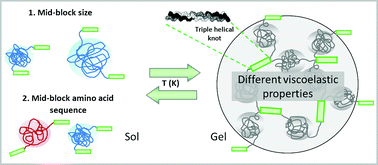Influence of molecular size on gel-forming properties of telechelic collagen-inspired polymers†
Abstract
We studied the influence of molecular size on the formation of transient networks by telechelic

* Corresponding authors
a
Wageningen UR Food and Biobased Research, Bornse Weilanden 9, Wageningen, The Netherlands
E-mail:
helena.teles@wur.nl, frits.dewolf@wur.nl
Fax: +31(0)317-483011
Tel: +31(0)317-480217
b Wageningen University Bioprocess Engineering, Bomenweg 2, Wageningen, The Netherlands
c Laboratory of Physical Chemistry and Colloid Science, Wageningen University, Dreijenplein 6, Wageningen, The Netherlands
d Dutch Polymer Institute (DPI), P.O. Box 902, Eindhoven, The Netherlands
We studied the influence of molecular size on the formation of transient networks by telechelic

 Please wait while we load your content...
Something went wrong. Try again?
Please wait while we load your content...
Something went wrong. Try again?
H. Teles, P. J. Skrzeszewska, M. W. T. Werten, J. van der Gucht, G. Eggink and F. A. de Wolf, Soft Matter, 2010, 6, 4681 DOI: 10.1039/C0SM00175A
To request permission to reproduce material from this article, please go to the Copyright Clearance Center request page.
If you are an author contributing to an RSC publication, you do not need to request permission provided correct acknowledgement is given.
If you are the author of this article, you do not need to request permission to reproduce figures and diagrams provided correct acknowledgement is given. If you want to reproduce the whole article in a third-party publication (excluding your thesis/dissertation for which permission is not required) please go to the Copyright Clearance Center request page.
Read more about how to correctly acknowledge RSC content.
 Fetching data from CrossRef.
Fetching data from CrossRef.
This may take some time to load.
Loading related content
